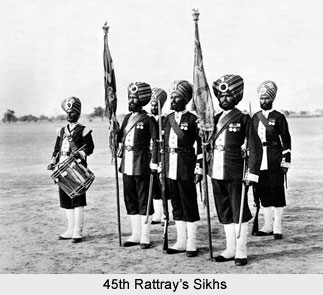 The 45th (Rattray`s Sikh) Native Regiment of Infantry, also known as 45th Rattray`s Sikhs, existed from the year 1856 to 1922. It was an infantry battalion created by the Honourable British East India Company. The unit was raised for service during the Sepoy Mutiny in 1857. The regiment was incorporated as a part of the Bengal Command. It also operated under the Bengal Native Infantry, which was division of the Bengal Army. The Bengal Presidency Army was amongst the 3 main Presidency Armies in British India.
The 45th (Rattray`s Sikh) Native Regiment of Infantry, also known as 45th Rattray`s Sikhs, existed from the year 1856 to 1922. It was an infantry battalion created by the Honourable British East India Company. The unit was raised for service during the Sepoy Mutiny in 1857. The regiment was incorporated as a part of the Bengal Command. It also operated under the Bengal Native Infantry, which was division of the Bengal Army. The Bengal Presidency Army was amongst the 3 main Presidency Armies in British India.
History of 45th (Rattray`s Sikh) Native Regiment of Infantry
The 45th (Rattray`s Sikh) Native Regiment of Infantry was raised by Captain Thomas Rattray as the 1st Bengal Military Police Battalion at Lahore in April 1856. The army unit initially included a troop of 500 infantry and 100 cavalry. The class composition comprised mostly of Sikhs and also included Muslims, Rajputs and Dogras from the North West Frontier and Punjab. The military force was developed and trained as an elite corps. The troops participated in the conflict in Sonthal Parganas in Bihar, which was a part of Eastern Bengal. Later the infantry regiment served in Assam and Bengal.
During the Sepoy Mutiny in 1857, the 45th Rattray`s Sikhs remained loyal to the East India Company. In the year 1864, the cavalry division was dissolved and the infantry division was incorporated as a part of the Bengal Native Infantry. It was designated as the 45th (Rattray`s Sikh) Native Regiment of Infantry.
Development of 45th (Rattray`s Sikh) Native Regiment of Infantry
The British Indian administration restructured and renumbered the entire army after the First World War. The various single battalion infantry regiments were amalgamated to develop multi battalion regiments. In 1922, the 45th (Rattray`s Sikh) Native Regiment of Infantry was renamed as the 3rd Battalion, 11th Sikh Regiment.
After the country gained freedom from the British colonial bondage in the year 1947, the nation was divided through the Partition of India. The British Indian Army was shared among the Union of India and the Dominion of Pakistan. The native infantry regiment was assigned to the modern Indian Army and was again re-designated as the 3rd Battalion, the Sikh Regiment. The headquarters of the regiment is located Ramgarh, Jharkhand.
Designations of 45th (Rattray`s Sikh) Native Regiment of Infantry
The 45th (Rattray`s Sikh) Native Regiment of Infantry held many titles and designations through out its service under the British Indian Army. The different designations are mentioned below-
* 1st Bengal Military Police Battalion (Rattray`s) - 1856
* 45th (Rattray`s Sikh) Native Regiment of Infantry, Bengal Native Infantry - 1864
* 45th Rattray`s Sikh Infantry - 1901
* 3rd Battalion, 11th Sikh Regiment - 1922



















